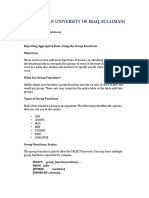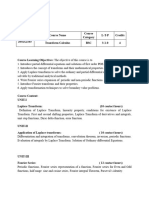0% found this document useful (0 votes)
71 views23 pagesGroup Functions in Database Management
Group functions allow you to perform calculations on groups of aggregated data rather than individual rows. The main group functions are COUNT, SUM, AVG, MIN, MAX. You use the GROUP BY clause to group data and the HAVING clause to filter groups. For example, you can get the average salary for each department by grouping rows by department and using the AVG function.
Uploaded by
jcgutz3Copyright
© © All Rights Reserved
We take content rights seriously. If you suspect this is your content, claim it here.
Available Formats
Download as PDF, TXT or read online on Scribd
0% found this document useful (0 votes)
71 views23 pagesGroup Functions in Database Management
Group functions allow you to perform calculations on groups of aggregated data rather than individual rows. The main group functions are COUNT, SUM, AVG, MIN, MAX. You use the GROUP BY clause to group data and the HAVING clause to filter groups. For example, you can get the average salary for each department by grouping rows by department and using the AVG function.
Uploaded by
jcgutz3Copyright
© © All Rights Reserved
We take content rights seriously. If you suspect this is your content, claim it here.
Available Formats
Download as PDF, TXT or read online on Scribd
/ 23




































































































